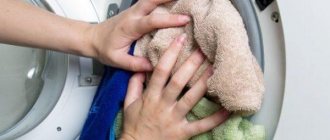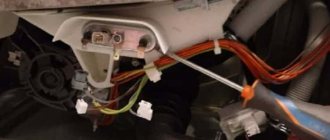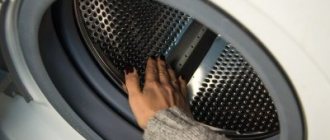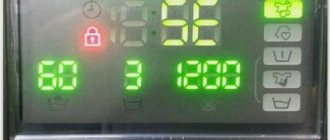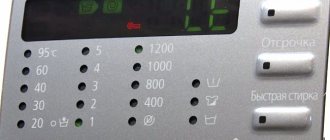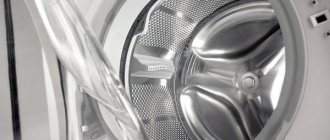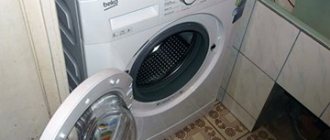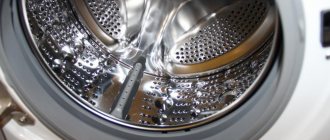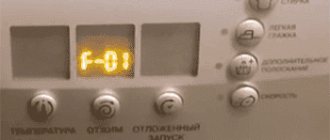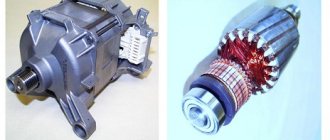If the washing machine drum does not spin, there can be a variety of reasons. The situation when the washing process has begun, but is not completely completed, is unpleasant, but you should not be nervous and fuss. What should I do if the drum stops while washing? A number of urgent actions need to be taken.
When the washing machine drum does not spin, it is important to determine the cause of the problem.
Washing machine drum does not spin
When the drum mechanism rotates weakly, jerkily, or even stops, the cause may be its elementary overload. In other cases, the motor, motor brushes, or software module could fail. Let's consider each case in more detail.
Machine overload
If the automatic machine barely turns during washing, you may simply have overloaded it or the things inside are unevenly distributed. This is the most harmless problem that can be eliminated by taking out unnecessary things.
After reducing the load, start the wash program again. If the machine starts working, then the worst is over.
New models of automatic machines - such as Ardo, Whirlpool, LG - are equipped with special sensors. If the load limit is exceeded, an error code will appear on the display or the machine will beep.
Units without sensors simply stop the wash cycle, signaling that a problem has occurred.
Drive belt wear
The drive belt transmits rotation from the engine to the tank. The operation of the device is disrupted if the belt becomes unusable: it stretches, frays or bursts. This can happen during active use or vice versa during prolonged downtime.
The worn part should be replaced with a new one.
Electric motor brushes worn out
This malfunction most often occurs with outdated models or those that are used frequently. Motor brushes wear out simply due to long periods of use.
They need to be replaced. There shouldn't be any difficulties with this. All you need to do is remove the engine and replace the worn part.
If after this the machine begins to make a lot of noise during operation, it means that the brushes were replaced incorrectly.
Engine failure
In this case, the drum mechanism begins to rotate more slowly until it stops completely in the future. In this case, the motor stops making sounds characteristic of its operation. It could be:
- Failure caused by voltage surges or leaks;
- Wear of brushes - this is written above;
- Capacitor failure is typical for older models.
The motor should be carefully inspected and additional diagnostics performed. In the best case, it can be repaired, in the worst, it will need to be completely replaced.
Software module malfunction
The software module that controls almost all the mechanisms of the automatic machine is also susceptible to breakdowns. Due to its wear or voltage drops in the network, the drum device also begins to jam. To eliminate a breakdown in electronically controlled cars, you will have to reset the programs. In models with electromechanical control, the board will need to be re-flashed or completely replaced.
How to clean the drum
An experienced owner, knowing how to clean a washing machine drum, carries out this work regularly. Dirt entering the drum during washing reduces its quality. Dirt is a source of mold and unpleasant odors. Scale resulting from hard water is especially dangerous. If you do not clean your car from dirt in a timely manner, it can easily fail. Therefore, the following means are used to clean the drum from dirt:
- vinegar;
- soda;
- whiteness;
- citric acid.
You might be interested in learning how to clean a washing machine with citric acid.
Why can’t you exceed the norm for cleaning substances? This is harmful for both the machine and the person. The whiteness will corrode the elastic of the cuffs and the elastic of the gaskets along with the dirt.
Adviсe
- Before loading laundry into the wash, carefully check all pockets, turn out duvet covers and pillowcases - this way you will be sure that small items will not get inside the unit.
- Before starting up your new machine, read the user manual carefully. Follow the recommendations regarding the size and weight of the laundry you load exactly.
- There are special bags for washing underwear and other small items. Experts strongly advise using these bags not only for the safety of things, but also for the safety of the washing machine.
- Do not use fabric softeners, bleaches, anti-scale agents, and do not exceed the dosage of washing powder. Components contained in household chemicals can damage the inside of the washing machine.
- If during the washing process the unit begins to make strange noises, cancel the program and unload all the laundry from it. If the situation repeats when you restart it, it means that the washing machine needs diagnostics and repair.
Arbitrary opening of the drum doors
In top-loading washing machines, a situation may arise when the drum flaps open directly during the washing process. Despite the fact that the design of the valves prevents their unauthorized opening, this situation is not uncommon. The worst thing this can lead to is destruction of the tank and deformation of the drum.
In such situations, the doors often open easily. Severe damage to the drum may prevent the machine from unlocking; in this case, you should contact a specialist.
Call a technician to repair your washing machine
Call a technician - stopping the engine, bearing wear, or the washing machine drum coming off the axle never “goes away” just like that. You can't do without repairs. Such malfunctions can be eliminated either by completely replacing the unit or by rearranging the bearings. But this is not always possible, because in some models of Ardo, Whirlpool or Beko washing machines, the tank and bearing are rigidly connected to each other.
The technician makes a decision on the repair procedure and technology based on an inspection of the machine after disassembly - if the problem lies in the electric motor, then it can be replaced completely, try to install new brushes or clean the commutator. If the drive belt in your washing machine has broken or loosened, then you are faced with the easiest problem. But this does not mean that it is enough to simply rearrange the belt, because it is necessary to check the condition of the tension mechanism.
Carbon brush wear
Hotpoint
washing machines from Ariston often encounter problems in the form of drum stops . And there are often cases when this happens due to worn carbon brushes.
Don't rush too much and immediately go to the store for new brushes. First, you should carefully examine their appearance and the condition of the adjacent engine parts. If the reason for the engine stopping really lies in the brushes, then at least one of the two will be black and charred. If the places where the brushes are attached to the engine look like new, and the brushes themselves are not smoked, then most likely they do not need to be replaced. Even if they both look worn out, the breakdown may be much more global. If the fittings themselves are worn out, replacing the brushes with new ones can lead to other breakdowns. Therefore, it is still better to entrust the diagnosis of such damage to a professional.
Finding the causes of drum failure
After identifying the problem, you need to follow these steps:
- Stop a running washing program;
- Disconnect the machine from the power supply;
- Drain the water through the drain valve. In most washing devices it is located at the bottom of the front panel;
- Pull out the laundry.
After that, we move on to finding the problem. You need to understand at what point the unit malfunctioned. The pulled out laundry will help with this. Having carefully examined it, you can find out the following:
- Soapy hair - the problem arose during the washing process;
- Things are wet - a failure occurred during the spin cycle.
What should be the next steps? First of all, you need to check the mobility of the rotating mechanism by hand. If it rotates at least tightly, this indicates that:
- The car was overloaded with a large number of things, or they were unevenly distributed inside;
- The motor drive belt is worn out;
- The electric motor brushes are broken;
- The engine broke down;
- The electronic module has failed.
If the mechanism is jammed, then the problem is as follows:
- The belt slipped;
- A foreign object is present;
- The bearings have failed;
- The doors of a top-loading machine opened;
- The capacitor is broken.
Next, you will learn how to act in a given situation: when you can try to repair it yourself, and when you need to call a specialist.
Filter clogged
The most common reason that the drum does not spin during washing may be a clogged filter. The fact is that when the filter is clogged, the washing machine performs an emergency stop and stops the washing program. In such a situation, the machine often gets blocked and the door becomes difficult to open.
You can clean the filter yourself. The instructions for the washing machine indicate the location of the filter and how it can be opened. In most washing machines it is located at the bottom of the front panel of the machine. Before dismantling it, it is advisable to cover the floor next to the washing machine with rags, as water may pour out of it.
In some cases, the filter can be accessed by slightly opening the decorative panel located at the bottom of the housing. In order to remove the filter, you need to turn the handle located on its front wall counterclockwise. See more details here: How to clean the drain filter of a washing machine.
Troubleshooting yourself
Let's look at the main common reasons when the washing machine drum does not spin:
An object is stuck in the space between the drum and the tank. One of the most common reasons why a washing machine breaks down is when something (something you usually forget to take out of your pockets) gets caught between the tub and the drum.
Try to rotate the drum manually - if it does not rotate, it means that a foreign object is interfering with it.
This is important: before starting work, be sure to unplug the plug from the outlet. What to do? Using a flashlight, shine the drum through the holes for draining the water and try to understand where the object is. Next, you need to independently remove the object through the hole for the heating element (electric heating device).
Please note: in some models of washing machines the heating element is located at the back, and to access it you need to remove the rear panel of the case
In other models, the heater is located in the front, then it will be necessary to remove the control panel.
The filter is clogged. When the filter becomes clogged, the washing machine automatically goes into emergency mode and stops working (usually during washing). In the instructions for the machine from any manufacturer (Indesit, Ardo, LG) you can easily find information about where the filter is located, and how to remove it, and how to put it back in place.
Expert tip: Before opening the filter cover, cover the floors with rags or place a basin under the filter cover. This will save you from subsequent cleaning.
The drive belt has broken or stretched. The drive belt ensures the rotation of the drum. If you use your washing machine for a long time (5 years or more), there is a high probability that the belt has stretched (during washing, the drum rotates more slowly) or has fallen out of place (when the machine is turned off, the drum rotates easily and there is no “rustling” of the engine). In this case, it is necessary to replace the belt with a new one (when purchasing a new belt, do not forget to write off the characteristics of the old one: belt length, number and size of wedges). To replace the belt, you need to unscrew the back panel of the washing machine, remove the old belt, put a new one on the drum pulley and, holding it in the recess with your hand, slowly rotate the drum until the belt is completely in place.
Should I repair the control unit myself or have it done by a specialist?
These symptoms may have different causes. In older models, similar ones may appear due to a breakdown in the capacitor. The capacitor failed and the drum first began to creak and then stopped spinning. Such a breakdown only affects certain older models of washing machines that have it.
The most complex element of a washing machine is its electronic module, which is based on a printed circuit board. This is one of the reasons why the drum stopped spinning during the spin cycle. It contains control elements and interacts with all the sensors of the machine, including the pressure switch.
The problem is the difficulty of recognizing the essence of the breakdown. What is faulty: the module or the drum? Starting to repair a module without sufficient grounds is fraught with disruption of its operation and the loss of a significant amount of money. However, there is no guarantee that the repair will give a positive result. Replacing with a new module will not give positive results: it may burn out, because the cause of the failure has not been established.
To establish it, the module must be diagnosed. In modern cars, it itself indicates a malfunction during the test. In order to definitively verify that the electronic module is faulty, one test is not enough. The test is carried out differently for each brand of car. You can find the algorithm for doing it in the instructions for the unit.
The electronic module controls the operation of almost all components of the washing machine. Incorrect operation of the control module may result in the drum rotating slowly or remaining stationary altogether. To eliminate the malfunction, it is necessary to repair the module or replace it. Repairing and checking the condition of the electronic module requires the use of special knowledge and skills; independent repair of the part can lead to a worsening of the situation.
Read more: Do-it-yourself repair of a single-lever kitchen faucet
The machine does not spin: 7 systemic reasons
When the mechanism does not move, although before it was easily rotated by hand, the following malfunctions are possible:
- Belt break. Elimination of breakdowns, typical for models with a long service life, is carried out by replacing the damaged product with a new analogue. This requires removing the back cover. Less commonly, the belt slips off the electric motor pulley, which can be easily repaired on your own.
- Automation failures. In case of breakdowns associated with a violation of the functionality of the software module, the optimal solution is to contact a service center.
- Speed controller failure. If the drive does not rotate during spinning, the device that controls the intensity of rotation—the tachometer—may fail.
- Burnout of the heating element, causing its rupture, can cause the motor shaft to stop when it cannot rotate the tank.
- Water level sensor failure. When the control unit does not receive a signal about the presence of liquid in the tank, the electric drive does not start.
- Wear of electric motor brushes most often occurs during intensive use of equipment or during long-term operation. Replacement of faulty parts is carried out after preliminary dismantling of the engine.
- Problems with the drive can be caused by a break in the power supply circuit, a short circuit, jamming or destruction of the bearing when the device hums but does not rotate the shaft.
In any case, if the question arises: what to do if the drum does not rotate, contact a specialist. Remember, high-quality troubleshooting requires not only certain qualifications or experience, but also a specific tool.
The design of automatic machines and possible reasons for their failure to operate
The design of modern washing machines, equipped with many modes and allowing you to clean almost any stain, is quite complex and consists of many parts. Due to their complexity, such systems are susceptible to a variety of breakdowns. Moreover, even the most expensive models from the world's leading manufacturers easily break down and fail. Of course, the products of any Chinese manufacturer are much more susceptible to similar problems, but the largest European brands are not immune to them either. Indesit, Bosch or Electrolux guarantee the quality of their products, but the operating conditions of such devices still leave their mark and contribute to their failure.
We recommend that you read
In such a situation, one of the most common problems that arise during the operation of the equipment is the fact that the washing machine does not spin the drum. There can be a great many reasons for a similar phenomenon. The best solution, designed not only to save your own time, but also to preserve the design of the machine, is to call a specialist. This is the only way to guarantee its effective repair and be confident in the integrity of the device. However, such a solution requires certain material costs, which makes it not always successful. At the same time, it is possible to independently identify the problem and even neutralize it.
The most common reasons why the drum in a washing machine does not spin are violations of fairly simple principles embedded in the machine’s control system. They look like this:
- the maximum weight of the laundry has been exceeded;
- The drain filter is clogged.
It is quite easy to diagnose such problems yourself, since they are obvious. In this case, the drum is blocked by the system itself, which limits user access to the device. Such settings are set by the manufacturer and provide a kind of protection against damage to the device. In the first case, to unlock the device, it is enough to partially unload the laundry. In the second, things are a little more complicated, since obstruction of the drain filter requires partial disassembly of the device. However, cleaning it can bring positive results and ensure full operation of the device. It gets clogged primarily with small parts that fall into it directly from the drum. This could be anything small that penetrates the rubber seals, such as handkerchiefs, baby socks, or pieces of lint. Therefore, you should be careful when placing laundry in the drum of the machine, since this is the only way to avoid clogging the filter and thereby guarantee the smooth operation of the device.
When the machine does not spin: what to do
The most common and easiest problem to troubleshoot if the drum does not rotate can be overload. Most modern models are equipped with a built-in system for forced stop/refusal to start in case of excessive loaded weight. Indirect confirmation of this situation are the following points:
- the machine does not respond to switching on;
- after pulling out the laundry is completely dry, since no water is collected;
- The storage tank is not jammed and is easy to turn by hand.
In this case, you should not rush to call a technician; most likely, the new equipment is not broken. The automation simply does not turn on due to exceeding the permissible weight. Load half the items and turn on the wash cycle again. If the device starts to work, monitor the total load weight more carefully next time.
Household reasons
The presence of many sensors that are sensitive to various faults and at the slightest deviation from the norm are able to stop the rotation of the drum.
First of all, we try to eliminate the simplest faults. To do this, let's try to unload the machine from excess laundry. We turn on the washing program again and monitor the result of these actions.
If the machine still does not start spinning, you need to disconnect the washing machine from the power source and try to open the loading hatch. If the door does not open, and we see the presence of water inside the machine, then we can say with 95% confidence that the water drainage system is clogged.
If the drum does not rotate before the water fills, but the hatch door opens, a foreign body may enter the washing machine tank. When we try to turn the drum by hand, we will immediately understand whether it is jammed or not.
To clear a clogged drain system, you first need to drain the water from the tank. This operation can be performed through a filter, which is located on the front panel in the lower right corner of Samsung. Having carefully unscrewed the filter, having previously laid down a soft rag so as not to flood the floors in the room with water, we drain the tank. Then, having completely dismantled the filter, we thoroughly clean it of dirt and foreign objects.
If cleaning the filter does not bring a positive result, you need to completely disconnect the washing machine from the communications. Next, you need to clean the drain pump and drain pipe. To get to these parts, the car will have to be placed on its left side. Having removed the pump and pipe, we clean them of debris and foreign bodies. After these procedures are completed, the washing machine starts in normal mode.
If a large foreign body gets into the washing machine tub, the drum may jam. If we discover just such a malfunction, we need to immediately turn off the machine and stop all attempts to turn the drum. Otherwise, you can get even bigger problems with the operation of the machine. Next, tilting the car on its left side, remove the drain pipe and try to remove the foreign object through this hole with your fingers. If it was not possible to remove debris from the tank, you will have to remove the heating element and clean the tank through this hole.
Useful tips: how to avoid breakdowns
Any actions in the event of a breakdown (for example, when the washing machine drum stops during washing, water refuses to fill, liquid begins to drain at the wrong moment) are based on correct diagnosis of the problem. A pressure switch is responsible for controlling the flow of liquid, and the tank with the drive is a simple mechanical system.
The correct strategy for using a washing machine includes a mandatory check of the condition of the control elements and prevention. For example, all buttons must move freely, they must be cleaned, preventing the accumulation of salts or grease residues.
Similarly, mechanical relays must reliably lock positions and click clearly, which indicates clean contacts and good transmission of electrical current.
Simple maintenance of the machine should not be neglected. It is necessary to drain the remaining liquid from the outlet filter if this is provided for by the design of the washing machine. It is necessary to dry the insides of the drum, and also avoid operating the device without grounding and at power parameters that do not correspond to those declared by the manufacturer.
Simple preventive maintenance, checking the condition, preventing excessive loading, drying and cleaning will help to maintain the ideal performance of the automatic home assistant for a long time.
If the drum rotates freely
If rotations are present under the influence of external force, then breakdowns occur as follows:
- Damage to the belt (this item does not apply to direct drive models). A problem is indicated by noise from the engine, but the laundry does not spin. The belt can be inspected by removing the back panel. The part wears out both with active use of the unit, and during idle time it dries out and cracks. If the drive belt is frayed or loose, it must be replaced. Before purchasing a new belt yourself, you should study the markings of the old one. You need to find out its length and number of wedges.
- The motor brushes are worn out. With prolonged use, the brushes become shortened and no longer reach the commutator. As a result, the electromagnetic field necessary for rotor movement is not generated. During operation there will be no noise from the engine. When the brushes are completely worn out, they need to be replaced.
- A wiring fault in the device itself prevents voltage from being supplied to the motor.
- Problems with the electronic module or programmer. The first is installed in electronically controlled devices, the second is typical for electromechanical ones. This means that the control board, which should transmit a signal to start washing, is not working. Problems most often arise due to power surges in the network or forced manual adjustment of programmed operating modes. The repair consists of flashing the old board or installing a new one. If there is simply a failure in the module, it is enough to perform the program reset procedure.
- Electric motor failure. Problems with this part of the unit occur infrequently. They mainly occur during operation for more than ten years. Malfunctions occur due to changes in the electrical network or leaks, as a result of which water enters the engine. If there is a short circuit between the turns of the motor winding, then the empty drum can rotate. However, when starting the device, the plugs will immediately pop out. A broken winding will completely jam the machine and it will not move at all. It is better to resolve this issue to a specialist who will diagnose and repair or replace the engine.
Decoding fault codes for the Indesit washing machine
How to repair bearings yourself
If the owner of the unit does this, it will be useful for him to know how to remove the bearing from the drum of the washing machine. This work is not easy, so it is better to carefully study the theory and then get down to business. The bearing is jammed; to replace it, the unit is almost completely disassembled. You need to remove the drum and tank from the car. To do everything correctly, you need to know how to disassemble the drum of a washing machine:
- The tank has two parts, bolted or glued together. The bolts are unscrewed, the glued parts are carefully sawn.
- The drum pulley is unscrewed with a key (star) or knocked out using a chisel or hammer.
- Then, loosening it, it is removed from the screw. This is where the bearings are located in the unit.
- To separate the tank and the drum, you need to knock the drum shaft inside the machine.
- Bearings that are jammed prevent the drum from spinning, since they are located on its outer and inner sides.
- They are removed with a special puller or a metal rod placed under the bearing race, which must be knocked out in a circle with a hammer.
- The small bearing is removed first, then the large one.
- Before the bearings, the seals are removed and must also be replaced.
Why do you need to listen to the machine while working? This is especially important during spinning, in cases where water does not enter the drum or the belt is worn out. An iron grinding, creaking or noise noticed in time will help get rid of problems with the repair of the entire unit.
If, when rotating by hand, the drum does not budge, or rotates very tightly, and this is accompanied by grinding and squeaking, the reason is probably damage to two parts of the washing machine at once - the oil seal and bearings. The oil seal is a special sealed seal that protects the bearings from water penetration.
To eliminate the malfunction, it is necessary to replace the bearings, and in some cases, the oil seal. Replacing the oil seal and bearings on your own and without proper experience is problematic; it is better to entrust this to a professional.
The washing machine drum may not rotate due to lack of voltage to the motor. This situation may arise due to a breakdown of the control module or faulty wiring inside the washing machine. To troubleshoot the problem, examine the wiring for leaks.
Debugg
To access the damaged part of the washing machine, you will need to partially disassemble the household appliance. The best way to access the inside of a household appliance is to remove the back cover.
This option is ideal for disassembling LG or Ariston Hotpoint machines. On some Samsung, Indesit and Bosch models, in order to get to the internal parts, you will first need to remove the top cover of the household appliance. Before you begin disassembling the washing machine, you should remove the power plug from the socket and also turn off the water supply to the device.
The top or back covers are secured with screws that can be easily removed with a screwdriver. After access to the internal parts of the machine is opened, depending on the cause of the malfunction, a certain sequence of actions is performed.
Replacing bearings
If the reason that the drum has come off the shaft is a faulty bearing, then repairing the household appliance is only possible by replacing these parts. The operation is performed in the following sequence:
- The top and bottom weights are removed. As a rule, in order to remove these parts, it is enough to unscrew 4 bolts.
- Carefully remove the drive belt from the pulley.
- The heating element is removed from the tank.
- The plastic clamps of the shock absorbers are removed.
- The springs are released.
- The electric motor is dismantled.
- The pulley is removed from the rotating part.
Now you will have access to the bearing, which should be removed using a special puller. What to do if there is no such tool? In this case, you can use a hammer and any oblong object of small diameter to knock the product out of its seat
When removing a bearing in this way, care should be taken, as careless actions can lead to damage to the rotating part of the household appliance.
When the old bearing is removed, a new part is pressed into its place, after which the car is reassembled in the reverse order.
Shock absorber repair
If the drum falls off due to a faulty shock absorber, then this part can also be easily repaired on your own. When the rear cover is removed, you should find the mounts on the rotating part of the machine to which the shock absorbers are attached. On many models there are at least four such elements, so you should inspect each one for damage.
Sometimes the spring can simply fly off the mount, so to restore the functionality of the device, it is enough to install the shock-absorbing element in place. If the spring breaks, it should be replaced with an original product.
Some models of washing machines use dampers as shock absorbers. If such a part is damaged, you will need to purchase a new product or remove it from a faulty “donor” of the same model.
Replacing the drive belt
Sometimes the reason for the drum moving out of its seat may be a heavily worn drive belt. In this case, you cannot do without replacing this part. This is quite easy to do, because each product has markings, which will make it easy to choose a new belt.
The belt is first put on the electric motor pulley, and then installed on a larger diameter wheel located on the tank. To make the task easier, you can pry the belt with a screwdriver, but even a new, undeveloped belt is usually easy to put on by turning the pulley 1 turn, after first throwing the part onto the wheel.
If the drum in the washing machine falls off, then it is absolutely not necessary to seek help from specialized workshops. You can save a lot if you carry out the repairs yourself according to the recommendations given in this article.
DIY repair
If the washing machine drum does not spin during washing, you can try to fix it yourself. However, devices from different manufacturers differ from each other in some design features and technologies used. Therefore, the repair sequence depends on the model of the washing machine.
Indesit
Let's look at an example of repair using the horizontal loading model WIXL83. If the drum does not spin when the Indesit washing machine is turned on, you should immediately check the belt drive and motor. To repair, the washing machine is unplugged, turned around and leaned on something so that the back wall is free. Next, unscrew the screws securing the oblong hatch, behind which there is a belt drive and an electric motor.
If the belt is intact, then you need to check the motor brushes. Power may not be supplied due to worn brushes or a dirty commutator. The electric motor is secured with two bolts; before unscrewing them, the block with wires is first disconnected. After removal, you can check the length of the brushes and the condition of the commutator. The latter, if necessary, is cleaned to a metallic shine. Short brushes are replaced with new ones.
Samsung
Possible reasons for the drum stopping on a Samsung washing machine are similar to other models. When replacing brushes, you need to make sure that they move freely in the brush holders. Sometimes, due to accumulated contaminants, the forces of the springs are not enough, and the contact is broken. When the electric motor operates, coal dust gets into the gaps and the brushes jam. The problem is solved by removing the brush holders and cleaning the holes.
Another reason for stopping the electric motor is a breakdown of the tachometer located on the rotor. It records the engine speed and transmits information to the electronic control unit. In appearance, the knot looks like a small metal ring, sometimes covered with a plastic casing. There are 2 small diameter wires coming from it.
The tachometer is checked with a multimeter (tester) in ringing mode. The wires are connected to the device and the rotor of the electric motor is rotated by hand. If the sensor is working properly, the multimeter will make short sounds (the needle oscillates). Otherwise, replacement will be required.
LG
In an LG washing machine equipped with a direct drive from an inverter motor, the drum does not spin or jerks slightly due to a broken Hall sensor. When you try to turn it on, a whistling sound is made.
To access the engine, you need to disconnect the unit from the mains and remove the back cover, which is held on by four self-tapping screws. Next, unscrew the central engine bolt. To do this, you will have to fix the rotor. A screwdriver is inserted obliquely into the upper vertical slot of the protective disk and pressed against the head of the hidden bolt. Then unscrew the 6 fasteners of the disk with coils and remove it.
On the back side of the removed element there is a Hall sensor. It is fixed with plastic latches, and the connector is disconnected before dismantling. Use a knife or flat screwdriver to pry up the fasteners and the sensor is easily released. Having replaced the damaged element, everything is assembled in the reverse order.
Bosch
When the drum stops in the Bosch Maxx 5 washing machine, error F21 appears on the display. The machine does not carry out the program and does not fill with water. First, after disconnecting from the network, you need to check with your hand the free rotation of the drum. If everything is in order, inspect the belt drive. Access is via the rear hatch.
If the belt is intact, you need to remove and check the electric motor. To do this, perform the following steps:
- remove the belt;
- place the machine on its right side;
- remove the bottom cover (you will need a T20 sprocket);
- disconnect the block with wires from the engine;
- unscrew the 2 mounting bolts;
- remove the engine.
The tachometer is checked by ringing with a multimeter. If it is in good working order, you need to remove the brushes and replace them if necessary. The sequence of disassembly and assembly of the Bosch Max 4 and some other models in this series is similar.
Beko
The main reason the Beko washing machine drum stops is wear on the brushes of the commutator motor. When turned on, the machine draws water, and then stops showing signs of life. The algorithm of actions for replacing them is standard, but there are some features. Access to the engine is through the rear hatch. By unscrewing the screws and removing it, you can inspect the internal mechanism.
Before removing the engine, you need to release the transmission belt and disconnect the block with wires. The electric motor housing is secured with two bolts with heads that have sprocket cutouts; to unscrew them you will need a T40 socket.
The brushes are inserted into special holders, which are secured to the motor housing with screws.
After replacing the worn elements, everything is reassembled in the reverse order.
Zanussi
Replacing brushes in a Zanussi washing machine is not difficult. But you won’t be able to get to the engine through the rear wall. To implement your plan, you need to place the machine on the floor face up. From below there is access to the motor. It is not necessary to remove it. The brush holders are fixed with self-tapping screws; they are removed after first unscrewing their fasteners and disconnecting the connectors.
The lack of contacts may be due to wear, jamming of the brushes in the guides, or contamination of the armature with coal dust or burning. All causes must be checked and eliminated. The plastic brush holder is disassembled into two halves and the metal guides and brush are removed from there. If you don’t have the part you need for this particular model, you can look for a replacement. It is enough to select brushes of suitable sizes from other units, you just have to solder the wires.
Electrolux
The Electrolux dryer also has a drum, which due to malfunctions one day refuses to spin. The main reason for this problem is wear of the support rollers on the engine or housing. The problem is solved by replacing them. To access the internal mechanisms, remove the side walls and top.
The engine is not removed, but only the tension spring on it is unhooked with pliers. After this, the entire assembly can rotate freely. Next, the old video is removed and a new one is installed in its place. The compressor housing interferes with these manipulations, so it will have to be tilted slightly. Before installation, the shaft is lubricated. Then I set the belt straight and put it on the engine. The drum is rolled by hand several times to obtain the parts of the working position. At the end, fix the tension spring and secure the side walls.
"Ariston"
In addition to the listed reasons for the drum not rotating in washing machines, there are unusual cases. One of them is broken wires. This sometimes happens after inattentive self-repair after removing the engine or drum.
In the Ariston washing machine, the electronic unit is located on the rear wall at the bottom left. The blocks with wires are connected from the inside and directed inward. When performing any manipulations or moving large components, an unintentional impact on these elements is possible. As a result, the pads are crushed or the wires are torn off. Moreover, the gap may not be visible, but there is no contact.
Therefore, before repairing the electronic unit, you should carefully check the integrity of the connections with the device; perhaps the malfunction occurred due to missing contacts. Please note that the connecting blocks are made of thin plastic and disassembly must be done carefully.
"Ardo"
A malfunction occurs when a full drum tries to turn during washing, but cannot, spinning does not occur. It feels like there is not enough power. This is typical for washing machines with asynchronous motors, such as Ardo. Power loss occurs due to a decrease in the capacity of the starting capacitor.
If you open the back wall of the Ardo washing machine, the part you are looking for can be found at the top right above the drum. Using a 12 mm socket, unscrew the fixing nut and remove the capacitor. The failed part must be replaced with a similar one. Ardo has a 16 mF capacitor. If you install an element with a larger capacity, the engine will overheat, if you install a smaller one, the power will be lost.
Imbalance or overload
Many, but not all, washing machines are equipped with systems to detect overload and imbalance of laundry. These are different problems, but when they are detected, the electronic module blocks rotation. This is done in order to prevent damage to the SMA units, which were not originally designed for such loads.
Overloading is exceeding the permissible weight of the laundry.
Imbalance is the crowding of things in one part of the drum. As a result, parasitic centrifugal forces may arise.
Do you wash your shoes in the machine?
Oh yes! No
These problems are defined in different ways:
- special sensors;
- The rotation speed is analyzed using a special algorithm.
Since such functions are implemented on expensive washing machines, the user is usually notified through messages or error codes that are displayed on the display. Note that decoding is carried out using a special table or using the operating instructions.
We get foreign objects
So, the belt is in perfect order, let's move on to checking the drum. It is likely that a small object in the form of a clothing button or key got into the free space between the tank and the drum, and the element stopped rotating. In this case, operating the machine is not recommended, as the object may cause jamming or damage to the drum walls. In each case, the situation requires expensive repairs associated with replacing the internal parts of the machine.
It is easy to determine the presence of a foreign object in the tank. To do this, you need to open the loading hatch door and turn the drum manually, first in one direction, then in the other. The presence of resistance, extraneous grinding or ringing will indicate that you are on the right track. All that remains is to remove the foreign object as quickly as possible, and for this there will be difficult steps, since you will have to work with the drain filter or the hole located under the heating element.
The first algorithm of actions is as follows:
- At the bottom right we find a hatch intended for draining;
- open its lid;
- spread rags on the floor;
- remove the garbage filter;
- We clean the body, sleeve, pipes.
Larger items remain at the bottom of the machine tank. To get to them as quickly as possible, you will have to dismantle the back panel, turn off and remove the water heating element. All that remains is to use a flashlight to find a foreign object and remove it using wire or pliers
You will have to act carefully so as not to damage the tank body.
If the drum stops rotating and is completely jammed, the tank must be completely disassembled. We proceed as when replacing a bearing - remove the panels at the top and rear, dismantle the drive, electric motor, dispenser with module, counterweight elements, shock-absorbing devices and other machine components. After completing these works, we take out the main container, disassemble it and remove foreign objects. The difficulty arises if the tank of the car is made in a non-separable form. It will take four hours to complete the cut, and it is better to entrust such work to an experienced specialist.
What causes weak rotation?
Before you take active action, you need to find the root cause of the drum braking. Depending on the nature and scale of the trouble that occurred, the tactics and methods of the required repairs will be determined . What problems might there be?
It is strictly not recommended to repair, flash or replace the control board yourself - there is a high risk of permanently damaging the part.
The drum also does not rotate well if there is an internal short circuit or damage. This item includes several possible culprits, so diagnostics and correction should be carried out by specialists. To better understand what happened, it is worth conducting an initial diagnosis.
Studying the situation
After the preparatory process is completed, you can begin a detailed study of the breakdown of the washing machine. You can do this yourself if you follow simple steps. Then the breakdown is quickly determined and a repair method is prescribed accordingly.
We must carefully remember the moment when the drum in the car stopped spinning. To do this, there is an option to look at the removed laundry. For example, if the laundry is just wet and there are no traces of powder on it, then the drum probably stopped spinning during the spinning procedure. If the presence of washing powder is observed in the items that were removed from the washing machine, then the drum of the unit has stopped rotating directly while washing the clothes. Now you need to turn it yourself
To do this, you need to grab the inner ribs of the drum with your hand and give it centrifugal force. If in this process the drum does not want to spin, then most likely the reason for this stop is that there is a foreign object that does not allow the drum to spin. If the drum itself rotates quite freely, then the whole problem will be in the electronic filling of the washing machine. When determining the reason why the drum of the washing machine does not spin, one must also take into account such a circumstance as drum overload. Quite often, users, in an effort to wash a large volume of laundry in one process, allow a violation of the drum load
Then it can simply stop during the washing procedure. Therefore, as a way out, you can try to divide this laundry into two parts and wash it again. In connection with this point, it should be noted that the latest modifications of washing machines already have a special function that provides for monitoring the weight of the laundry loaded into the drum. For this purpose, special sensors are installed. If, as a result of loading, the nominal weight is exceeded, the sensor stops the wash and the drum stops spinning. At the same time, in a number of models there is also a visual indication, which makes it clear to the user that a weight overload has occurred. It is also necessary to pay attention to external circumstances that may affect the operation of the system. For example, a number of washing machines have a sensor that is very sensitive to water pressure readings in the supply system. If these data do not correspond to the norm, then it will react adequately and de-energize the machine.
How to properly repair a unit?
There are times when during the washing process the drum of the washing machine does not spin or does not start at all, while the activation worked and the indicators react.
According to statistics, 50% of a successful repair depends entirely on how correctly the fault options were identified, the remaining 50% depends on the experience of the technician who will repair the unit.
If the breakdown is simple, then you can deal with this problem yourself. In case of more serious problems, you cannot do without consulting a specialist and his services.
Content
Main reasons
The cause of the breakdown can occur anywhere, from bearing wear to the motherboard burning out. When identifying the exact reason why Ariston, LG or Samsung does not spin the rotating element, it is necessary to take into account the variety of modifications.
They have individual technical features regarding design characteristics. Each model has differences in components, their location and installation method. This may complicate the repair process a little if the washing machine is broken and the user intends to repair it himself.
There are many options for this problem, let’s look at the most common ones.
Owners of washing machines know that malfunctions appear when the machine begins to make unusual sounds in the form of loud noise and creaking at the last stage of washing, during the spin cycle. Water does not flow into the drum, the belt weakens or frays. But not all faults can be fixed by DIY repairs. Why is this not always possible? In order to carry out electronic and electrical repairs, you need special permission and professional knowledge.
Problems that are not considered breakdowns are usually solved independently. Why are they classified as problems? They are associated with violations of the operating rules of the unit. If the repair is carried out by yourself, the first step is to carefully study the instructions. When starting repairs, be sure to turn off the power to the unit by unplugging the plug from the socket.
- Extraneous sounds appear in the form of creaking and loud noise during operation of the machine, especially during spinning.
- The machine is turned on, the engine is running, but the drum does not rotate.
- The program is installed. The indicator lights come on, but the drum does not rotate.
- The unit is working. Water flows according to the washing program, but the drum has stopped spinning.
The reasons for module failure are as follows:
- Disconnection from power supply during washing.
- The influence of voltage drops.
- Moisture penetration.
- Manufacturing defects.
If you want to repair the module yourself, perhaps this video will help you.
Considering the difficulty of diagnosing a module and the risk associated with violating its integrity, owners most often use the services of professionals who diagnose the module at home. By repairing the module with your own hands, the owner risks, without solving the problem of a drum that does not rotate, burning not only the control unit, but the drain pump, electric motor and heating element. Therefore, when entrusting module repair to a specialist, be interested in his level of qualifications so that he does not cause losses.
- If the heating element (heating element) fails, it is very dangerous. A malfunction of this element can result in an explosion, which can block the operation of the unit. You need to take it out of the car: here you will need to replace it with a new one.
- Before the electric motor breaks down, the machine may experience loud noise and squeaking during spinning. If the electric motor breaks down, the reasons for its damage are water leakage and voltage surges. The problem of its restoration can only be solved by a specialist.
- The brushes are worn out: their contact with the electric motor has disappeared, and there is no necessary contact between them and the commutator. This happens because they have “burned out” (become shorter). The result was the absence of the electromagnetic field necessary to rotate the rotor. Even during operation, the engine stopped making noise. The brushes need to be replaced.
- The bearings are jammed. The machine first makes noise, then creaks, and before breaking down, an unpleasant iron grinding sound: the bearings are “scattering.”
If you do not pay attention to this warning noise, creaking and grinding, you can lose the unit itself. The danger is that if they fall apart during operation, they can seriously damage the machine from the inside. Therefore, the first grinding noise should be a signal for an urgent replacement of bearings and seals. To avoid complications, it would be better if this work is carried out by a specialist.
We figure out the problem ourselves
Primary diagnosis of breakdowns will be within the capabilities of any user. To do this, you must follow certain procedures:
- check the maximum weight of the laundry in the operating instructions;
- check that the door is not locked. As a rule, the drum stops spinning if the water drain filter is clogged;
- We try to turn the drum with our hands. If everything is normal, and a problem is observed during the automatic washing process, you should look for the cause in the wires, tachogenerator device, control module;
- It is imperative to inspect the cavity between the machine tank and the drum for the presence of foreign objects. If everything is normal, the heating element may have failed. The drum may also stop rotating due to a non-working heating element, thereby completely blocking the washing process;
- inspect the drive belt. It should be corrected or completely replaced with a new analogue;
The machine is disassembled and inspected to see if there are any problems with the bearings. It is quite possible that they also need to be replaced.
Other problems and breakdowns
The weight of the clothes exceeds the norm. This is not a breakdown, but a failure to follow the rules for operating the unit, which leads to tension in the operation of the machine: it makes noise, hums. You need to remove the excess, and the machine will start working as usual.
The water drain filter is clogged. Clean the filter. This element of the machine is located at the bottom of the front panel. Before cleaning, take care of the water container.
If the wiring inside the car has become unusable, you cannot do without diagnostics. This work should be carried out by a specialist.
The problem of the sensor, which regulates the number of revolutions during the spin cycle, can also only be solved correctly by a specialist.
